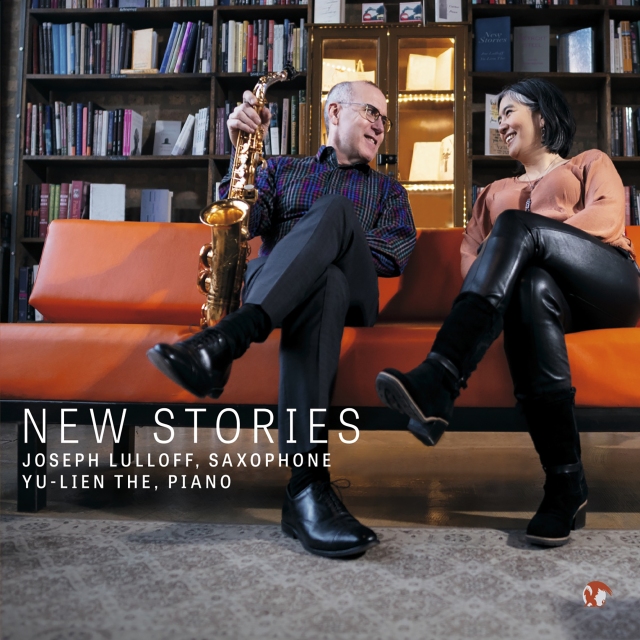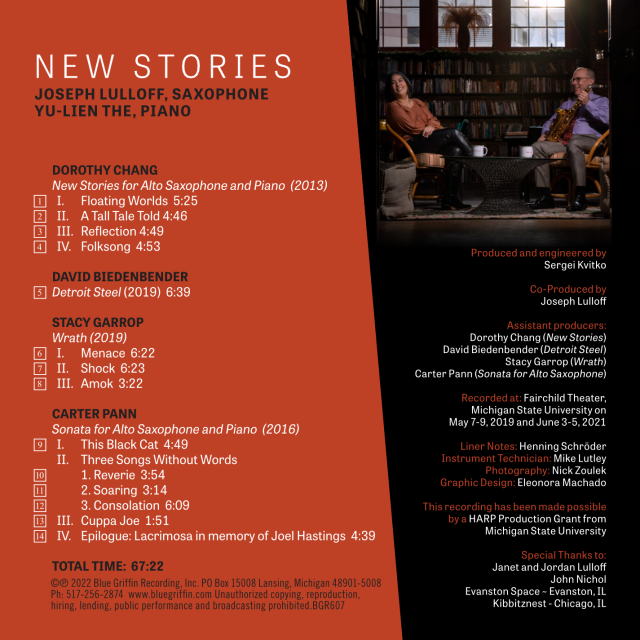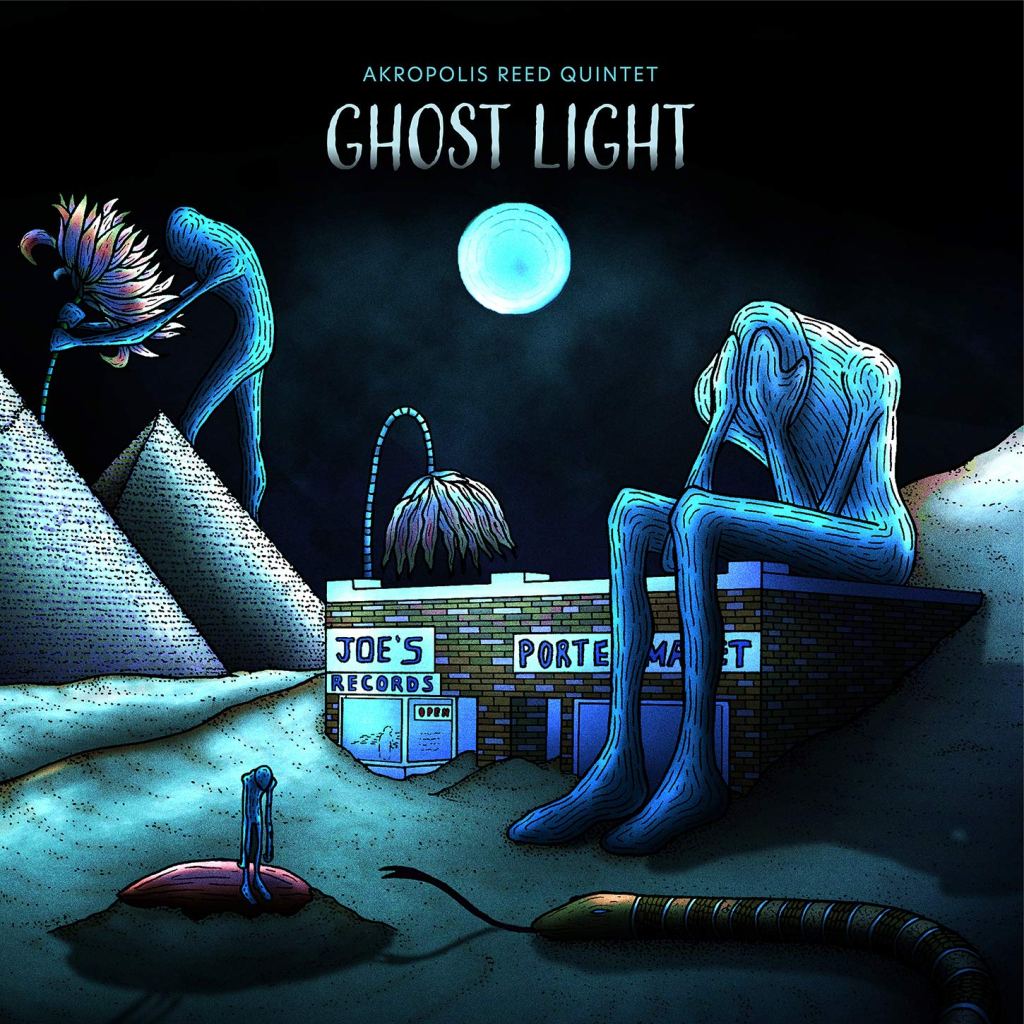
Joseph Lulloff (1960- ) is an internationally known artist with at least 10 CDs currently available. He is on the woodwind faculty of Michigan State University. Lulloff reportedly started playing saxophone in part to deal with asthma (a useful adjunct to pharmaceutical treatment) and has made quite a career since. Lulloff is a new name to this writer but, after hearing this latest release, a name that will trigger alerts on my listening radar. He, like most saxophone soloists working today, is equally comfortable and competent in both jazz and classical idioms for his instrument.
The present release is a collection of works, all written for the Joseph Lulloff. Four works are presented by four composers, two of which (Dorothy Chang and David Biedenbender) are new names to this listener. Overall this is one exciting release with deeply substantive music which makes a case that tonality and quasi romantic writing are not dead, just evolving.
Pianist Yu-Liien The is a fellow faculty at Michigan State and one who is clearly a sympathetic collaborator. The Netherlands born pianist has a wide range of international performances to her credit and is a major asset in the interpretation of the works on this CD. Their friendly collaboration is reflected well in the album cover photo by Nick Zoulek.
The recording itself is lucidly captured by producer/engineer Sergei Kvitko. Subtlties of both the saxophone and the piano come across clearly and this album is rife with subtle but very effective inflections of tone. It is a warm listening experience.

Dorothy Chang contributes the work from which the album derives its title. New Stories (2013) is a four movement work that is major opus, practically a concerto in all but name. At ca. 20 minutes total duration it reveals several moods and many challenges for the performer. This American composer writes in the useful liner notes that she attempts to utilize Chinese elements in her composition. These are not immediately apparent to this listener’s ears but what is apparent is the composer’s ability to create a very compelling listening experience.
The four movements include: “Floating Worlds”, an ethereal melodic/impressionistic movement which demonstrate the soloist’s fine and nuanced breath control and ability to integrate microtonal and multiphonic inflections in this relaxing movement punctuated with mildly dissonant piano chords. It is followed by “Tall Tale”, a scherzo-like movement which demands intricate interplay between the saxophone and the piano. The third movement, “Reflection”, is a somber solo for the saxophone, almost a cadenza. It is a lyrical slow movement that is relaxing for the listener but a challenge for the soloist, one that Lulloff handles effortlessly. The last movement, titled “Folksong” is a playful, busy movement that also incorporates a solo cadenza-like passage. It is a challenging interplay between saxophone and piano with rhythmic intricacies that sound difficult to execute. All in all a large and substantial work that almost begs to be orchestrated. But it stands clearly on its own very satisfyingly as a chamber work.
David Biedenbender is a composer new to these ears. His “Detroit Steel” is a solo saxophone work, a paean of sorts to the workers of the steel industry. This is the shortest work on the album but Biedenberger manages to create a cohesive soliloquy that sustains attention for the entirety of its 6 minute duration. Doubtless there are references in the work that were not immediately obvious to this reviewer but, like its companions on this release, it is an appealing sonic document.
Stacy Garrop, whose work has received praise in several reviews on this blog, again does not disappoint in her three movement, “Wrath” (2019), another concerto like work which is, according to the composer’s liner notes, is a sort of reimagining of an earlier work, “Tantrum” (2000), also for saxophone and piano. Written for Mr. Lulloff, Wrath is perhaps a representation of the composer’s evolving style and maturity.
The work is is three movements (Menace, Shock, and Amok). The sinister first movement gives way to the second, “Shock” which is more like a post shock experience (PTSD perhaps) seemingly reflecting some resolution of said shock presumably from the encounters in that sinister first movement. The finale, “Amok” picks up in a way from the menace of the first movement in a sort of return to that first movement in a cohesive transformation of that makes for a very satisfying finale. Garrop’s work seems to these ears to have a cinematic dimension and that is also the case here.
The album concludes with a large work by Carter Pann, an American composer whose star is steadily rising. The work, “Sonata for Alto Saxophone and Piano” (2016) is a four movement work which, despite its ordinary sounding title, is quite a fascinating piece. It shares a similar sound world to that of Paul Creston and mid 20th century neoromantics. The four movements (the second broken into three separate songs without words) are:
- Black Cat, apparently a set of variations which give the saxophone time to shine.
- Songs Without Words, three separate songs ranging from the melodic, romantic “Reverie” to the “Soaring”, a faster piece, and “Consolation”, a slow contemplative piece.
- Cuppa Joe, fast virtuosic scale work with manic piano accompaniment, sort of a scherzo.
- Epilogue Lacrimosa (In memoriam Joel Hastings), a somber homage to the Canadian pianist who championed Pann’s work.
This is a very exciting release by two fine musicians whom listeners will want to keep on their radar. This album is a significant contribution to the chamber literature for saxophone and a pretty wild listening experience.
























